Calculation of the cottage heating: selection, types of
With new construction or major repairs of a country house is very important is the issue of its heating. It depends on the comfort of living in a building during the cold season. On this basis, it is necessary to carry out a competent calculation of the heating system of the cottage.
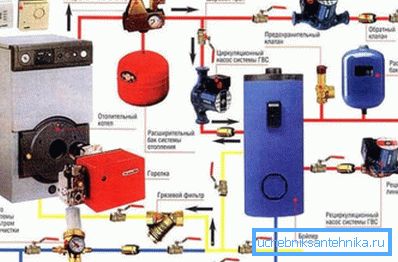
Under this network, experts understand the set of devices, which consists of:
- heat generator;
- pipeline;
- pumps;
- automatic devices;
- additional devices, the purpose of which is to transport heat to living rooms.
The reliability and efficiency of the system mainly depends on its proper installation, competent calculation of the number of batteries and their sections, network diagrams, etc.
Competent choice of heat generator
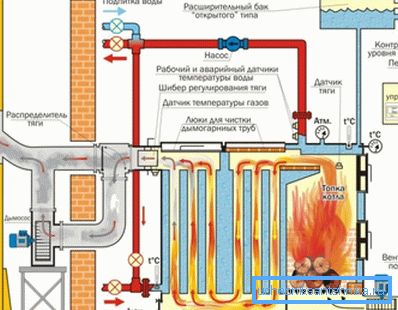
Heat generators can operate on:
- gas;
- electricity;
- liquid fuel;
- solid fuel.
Note! When choosing them, several factors should be considered. This is the efficiency of the heat transfer device, ease of operation, the price of a particular type of fuel in your area.
Types of devices
- So, electrical devices have high efficiency. However, they are not very common in Russia, due to the high cost of electrical energy and frequent interruptions in its supply. Regular voltage drops are also important, which leads to equipment damage.
- Fuel oil units are not environmentally friendly..
- Solid fuel analogues, due to their design features, cannot be equipped with convenient automation. Therefore, they require the presence of an operator who must regularly put fuel into their furnace (up to 4 times a day). The level of heat transfer from such a device is cyclical. It can fluctuate within 3/5 ° per day.
- There are two methods to compensate for the drawbacks of a solid fuel boiler.. It is possible to integrate a heat accumulator (storage tank) with a capacity of 2/10 m3 into the heating circuit. Or to prolong the period of fuel burning, thereby increasing its energy return and lowering the number of furnaces. This can be done with the help of devices (for example, thermo-balloons) that reduce the supply of oxygen to the boiler.
- When a building has gas supply, a gas fuel boiler will be the most convenient and cost-effective. Modern models of such devices have a high level of safety and efficiency (90/95%). Thanks to the cheap energy carrier, you will save up to 30% of the money allocated to provide the unit with fuel.
Note! If you have the opportunity to allocate a separate room for the boiler room, you can choose a heater with an open firebox. Such units are cheaper. If there is no such possibility, buy an analogue with a closed firebox.
Unit power

The efficiency of the boiler affects the efficiency of heating and the comfort of the temperature regime in the house. If it has insufficient power it will be cool in the rooms. At excessively high rates, the unit will consume a lot of fuel.
Making the calculation of the heating power of the cottage, take into account:
- the area of the room (S);
- specific unit capacity per 10 m3 of room (Wу).
The last parameter is adjusted by a coefficient that varies depending on the region of the site location.
Thus, the power density is:
- for the South of Russia - 0.7 / 0.9 kW;
- for the central regions of the country –1.2 / 1.5 kW;
- for the North of the Russian Federation - 1.5 / 2 kW.
The required power of the unit (Wк) is calculated by the formula: Wк = S • Wу: 10.
In living conditions, for convenience of calculations, the average value of specific power taken per unit is often used. On this basis, the required performance of the boiler is selected, at the rate of 10 kilowatts per 100 m2 room.
System diagram
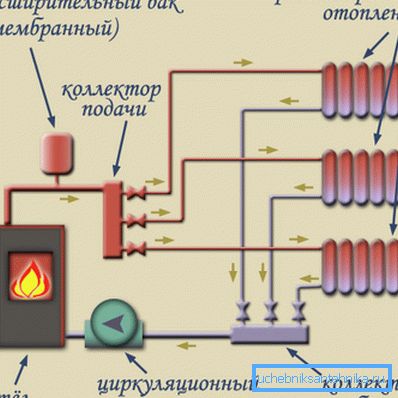
- The layout of the heating system depends on the area of the cottage. Its gravitational counterpart (natural circulation of the coolant) is not able to effectively heat a building that has an area of more than 100 m2. This is due to the small thermal inertia of the network.
- For bulk cottage, you must choose a system with forced circulation. They are carried out with the help of pumps that push the coolant and accelerate its flow along the contours.
- In order to extend the life of the unit, it can be mounted on the return branch of the pipes coming from the batteries to the boiler. So you will save the pump from the action of very hot coolant.
Note! In winter, the pumps are operated almost non-stop. On this basis, the device you purchased must be reliable, durable, silent, and have a small power consumption. Many modern heating boilers already have built-in pumps.
Pipeline features
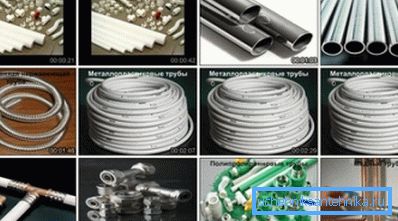
Heating pipes are divided into two large groups, they can be:
- metal: black steel, galvanized, steel-stainless steel, copper;
- plastic: polyethylene, polypropylene, combined (aluminum + plastic).
About types of pipes
Below are some of the features of these products.
- Black steel pipes are rusting. In addition, when assembling pipes with their own hands, welding is needed.
- Galvanized products are spared from these disadvantages. They do not corrode, you can connect them with threaded fittings.
- If you decide to hide the network in the walls, then the best option is to use copper pipes. They mate in the system with silver containing solder, using high-temperature soldering.
Such products can withstand pressures up to 200 atmospheres and coolant temperatures up to +200 degrees. Their use guarantees the durability and reliability of the pipeline for many decades. Disadvantages of products - the high cost and complex installation.
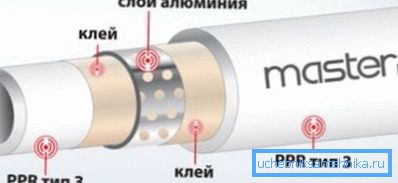
- The cons of metal products lack polymer counterparts. The most reliable of them are alumoplastic pipes. They consist of the upper and lower layers, between which glued aluminum foil.
The main advantages of such pipes:
- high level of strength;
- protection against oxygen diffusion, which prolongs the life of the network and saves it from corrosion;
- small amount of hydraulic resistance;
- anti-static;
- ease of installation;
- slow growth of deposits on the inner walls and their insignificance.
Metal-plastic pipelines can be installed without welding, using threaded connections. This circumstance simplifies and reduces the cost of assembly work.
- No less reliable products made of cross-linked polypropylene. They can withstand prolonged heating to +100 degrees.
Types of wiring
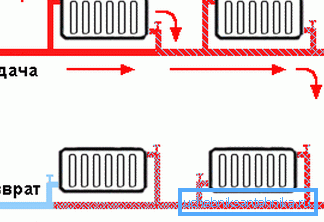
The number of pipes needed for arranging the heating system depends on the type of wiring that you choose.
- The two-pipe scheme makes it possible to effectively heat even very large rooms. If the system is equipped with thermostats, it will be possible to set the temperature conditions in all rooms separately.
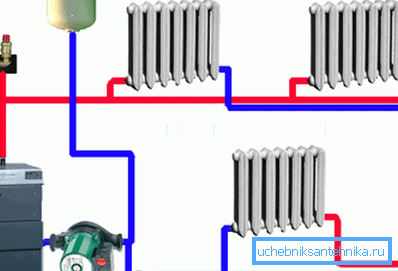
- The main advantages of a single-pipe heating system are simplicity of design, ease and low cost of installation.
Calculation of heating devices
The transfer of energy from the coolant to the rooms is carried out by heating devices.
There are such types of them:
- convective or ribbed counterparts;
- radiation devices, they are represented by infrared emitters;
- radiation-convective devices (radiators of all kinds).
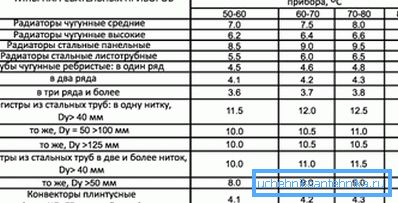
In our country, the most common of heating devices - sectional radiators.
The instruction warns that before installing them it will be necessary to calculate the number of sections needed for each room.
- For calculations, you need to know the thermal efficiency of one radiator section. It is divided by 100. There is another way - to find out what area can be heated by one section. And then, knowing the area of the entire room, it is easy to carry out the necessary calculations.
- Standard is considered the height of rooms 2.7 m.
- Let's give an example. The heat output of the section is equal to 190 W (it is always indicated by the manufacturers). Dividing this value by 100, we get an area of 1.9 m2, which can be heated by one section. Therefore, for a room of 20 m2, a radiator will be needed, consisting of (20: 1.9) 10.52 elements, rounded - from 11.
- When the room has access to the balcony or it is end, the number of sections is desirable to increase by 2/3.
Conclusion
If you want to create an effective heating system in your cottage, you will need to carefully calculate all its parameters. Calculations for domestic premises are not that complicated and you can do them yourself. The video in our article will help you with this.